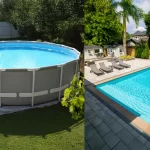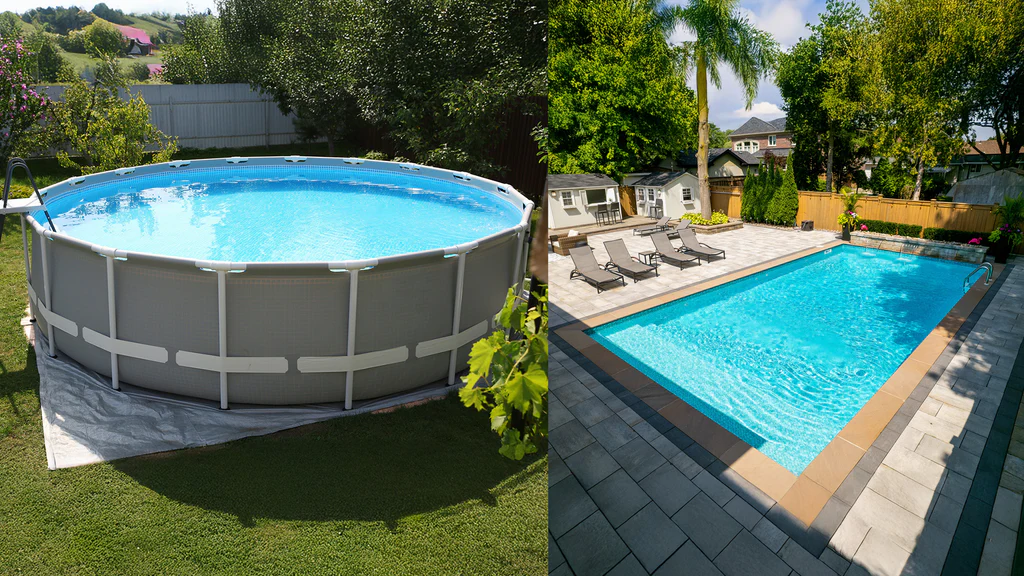Whether you are fitting your feature in demand, fitting a new view design, or are absolutely exhausted of the care costs, understanding the dissimilarities between these two types of pool evacuation is distracting.
Here is a detailed examination of what sets inground and above-ground pool replacement apart, and how to decide that approach best suits your situation.
In-Ground Pool Removal
Methods of In-Ground Pool Demolition are described below:
1. Partial Removal (Fill-In Method)
The top few extremities of the pool’s structure are disturbed.
Debris is compressed at the bottom.
Benefits:
Faster and less expensive
Disadvantages:
May restrict future creation or landscaping alternatives
2. Full Removal (Complete Excavation)
The entire pool construction, including the obstruction and floor, is destroyed and removed.
The hole is suffused and compacted, accompanying clean soil and gravel.
Advantages:
Allows brimming use of land for future building
Disadvantages:
More damaging and time-consuming
Why Select Full Removal?
Homeowners frequently select a brimming inground pool evacuation when preparing future construction projects like porches, gardens, or enlargements. It guarantees fundamental support and avoids potential conclusion issues later.
Above-Ground Pool Removal
An above-ground pool, in another way, sits lightly and is much more natural to destroy. These pools regularly include metal frames, vinyl liners, and detachable obstruction—making the removal process less invasive and more cost-effective.
Steps in Above-Ground Pool Removal
1. Draining the Pool
The water is drained completely.
2. Disassembling the Structure
Walls, liners, and frames are captured separately.
3. Removing Electrical Components
Power lines, pumps, and filters are cautiously discontinuous.
4. Hauling Away Materials
Metal and vinyl are reused or properly disposed of.
5. Restoring the Area
The ground is levelled, and new soil or lawn may be added.
Homeowners of Oakland CA usually remove above-ground pools on account of wear and tear, little usage, or the desire for more patio space. Since the process is easy, it is an ideal weekend project or professional task completed within a short timeframe.
Environmental and Landscaping Considerations
Both pool removals can have environmental implications, specifically in how waste is controlled.
Eco-friendly removal alternatives include:
- Recycling metal, concrete, and vinyl elements
- Using clean fill components
- Planting native plants post-removal to replace the environment
Decide the Perfect Material
Your conclusion depends on several determinants, including your budget, ongoing home plans, and the type of pool you have.
Key points to consider:
1. Plans for the room:
Full inground removal is best if you plan to build.
2. Property worth:
Completing in-ground removal increases resale flexibility.
3. Environmental goals:
Recycling matters and replacing natural scenes can enhance sustainability.
Professional Help Matters
- Permits and inspections
- Safe disposition of debris
- Proper compaction and ranking
- Final lawn and site rehabilitation
Conclusion
Whether you have an in-ground or above-ground pool, an evacuation offers a new start for your backyard and can increase your home’s utility and profit.
While above-ground pool removal in Oakland is more natural and more expensive, in-ground pool removal offers lasting benefits. Especially if you are planning for creation or revere boost resale appeal.
Understanding the distinctness between these two forms helps you build an informed judgment that fits your goals, budget, and plans—transforming your park into a safer, more active, and radiant outdoor region.

 How can you save money on moving & storage without sacrificing quality?
How can you save money on moving & storage without sacrificing quality?  OK.com Launches in US Market, Integrating AI Technology into Local Classifieds Experience
OK.com Launches in US Market, Integrating AI Technology into Local Classifieds Experience  Learn Everything About In-Ground vs. Above-Ground Pool Elimination
Learn Everything About In-Ground vs. Above-Ground Pool Elimination  The Smart Buyer’s Guide to Custom Canvas Prints in the UK
The Smart Buyer’s Guide to Custom Canvas Prints in the UK  Designing a Factory? Vastu Tips That Could Improve Energy Flow, Productivity & Profit
Designing a Factory? Vastu Tips That Could Improve Energy Flow, Productivity & Profit  How a General Contractor Manages Large Renovation Projects
How a General Contractor Manages Large Renovation Projects  Why Ongoing Support Is More Valuable Than a Low Initial Price When Installing Stairlifts In Scotland?
Why Ongoing Support Is More Valuable Than a Low Initial Price When Installing Stairlifts In Scotland?  How To Repair The Roof Penetration That Causes Vent Pipe Leaks
How To Repair The Roof Penetration That Causes Vent Pipe Leaks 